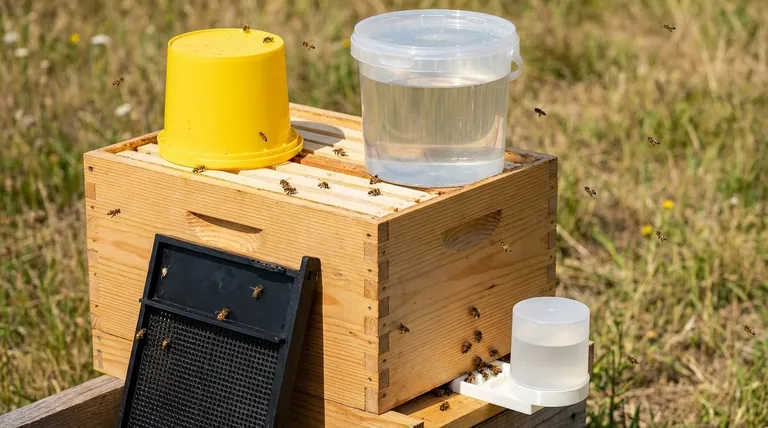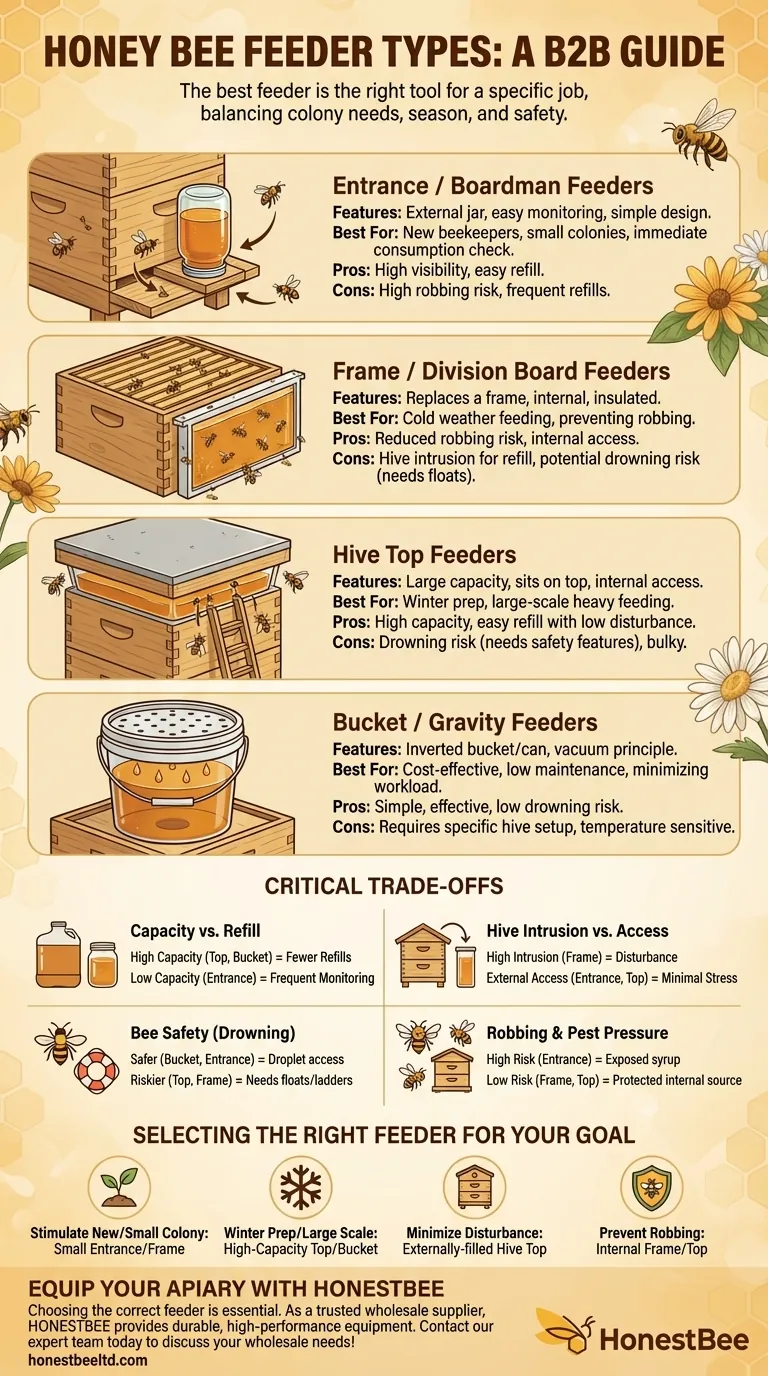The primary types of honey bee feeders are entrance feeders, frame feeders, hive top feeders, and bucket (or gravity) feeders. Each is designed with a specific purpose in mind, balancing factors like capacity, accessibility for the beekeeper, and safety for the bees.
The best honey bee feeder is not a single product, but rather the right tool for a specific job. Your choice should be guided by your colony's needs, the current season, and your management style, with a constant focus on preventing drowning and robbing.

A Closer Look at Common Feeder Types
Understanding the design and function of each feeder type is the first step in making an informed decision for your apiary. Each style interacts with the hive in a fundamentally different way.
Entrance / Boardman Feeders
These are among the simplest and most common feeders, especially for new beekeepers. They consist of a small tray that slides into the hive entrance, holding an inverted jar (typically a Mason jar) of sugar syrup.
They are easy to monitor and refill without opening the hive. Their visibility makes them a great indicator of when the colony is actively feeding.
Frame / Division Board Feeders
These feeders are designed to replace one or two frames inside the brood box or super. They are essentially thin, rectangular plastic containers with the same dimensions as a standard hive frame.
By placing the food source inside the hive, frame feeders dramatically reduce the risk of attracting robber bees from other colonies. They also allow bees to access food in colder weather without having to leave the warmth of the cluster.
Hive Top Feeders
As the name implies, these large-capacity feeders sit directly on top of the uppermost hive box, just beneath the outer cover. Bees access the syrup from below, often through a screened-off section or by climbing up internal ladders.
Their significant volume makes them ideal for periods of heavy feeding, such as preparing a colony for winter or during a nectar dearth. They are also very easy to refill with minimal disturbance to the bees.
Bucket / Gravity Feeders
This is a simple yet highly effective method. A bucket or can is filled with syrup, and a few small holes are pierced in the lid. The container is then inverted over the inner cover's central hole or directly on the top bars.
The vacuum pressure inside the sealed bucket prevents the syrup from flowing out freely, allowing bees to drink from the holes as needed. This design is cost-effective and reduces the beekeeper's workload.
Understanding the Critical Trade-offs
Choosing a feeder involves weighing competing priorities. What makes one feeder excellent for one situation can make it a poor choice for another.
Capacity vs. Refill Frequency
High-capacity feeders like hive top feeders reduce your workload by requiring fewer refills. This is a major advantage for beekeepers with many hives or for critical feeding periods.
Conversely, a small entrance feeder must be refilled frequently but gives you a more immediate, day-to-day sense of the colony's consumption rate.
Hive Intrusion vs. External Access
Frame feeders require you to open the hive completely for every refill, which can chill the brood and disturb the colony.
Entrance and many top feeders offer the significant advantage of being refilled externally. This minimizes stress on the bees and is much faster for the beekeeper.
Bee Safety (Drowning Risk)
Drowning is a serious and preventable risk. Open-style hive top feeders or frame feeders can be hazardous if they don't include safety features like floats, ladders, or textured inner walls to give bees a safe place to stand.
Bucket feeders and entrance feeders are generally safer in this regard, as bees only have access to small droplets of syrup at a time.
Robbing and Pest Pressure
This is perhaps the most critical trade-off. Entrance feeders are notorious for encouraging robbing, where bees from stronger nearby colonies overwhelm and steal the resources of the weaker hive. The exposed syrup can also attract ants and wasps.
Internal feeders, like frame and top feeders, keep the food source protected within the hive, making it much more difficult for robbers to locate and access.
Selecting the Right Feeder for Your Goal
Your choice should align directly with what you are trying to accomplish for your colony at a specific point in time.
- If your primary focus is stimulating a new or small colony: A small entrance or frame feeder allows for close monitoring of syrup uptake without over-feeding.
- If your primary focus is preparing for winter or large-scale feeding: A high-capacity hive top or bucket feeder is the most efficient choice to deliver large volumes of syrup quickly.
- If your primary focus is minimizing hive disturbance: An externally-filled hive top feeder provides the best balance of high capacity and low impact on the colony.
- If your primary focus is preventing robbing in your apiary: An internal frame or top feeder is the safest option, as it keeps the food source hidden from outsiders.
Ultimately, using the right feeder at the right time is a key management practice that supports a healthy, productive, and thriving honey bee colony.
Summary Table:
| Feeder Type | Key Features | Best For |
|---|---|---|
| Entrance / Boardman | Easy to monitor, external refill | New beekeepers, small colonies |
| Frame / Division Board | Inside the hive, reduces robbing | Cold weather feeding |
| Hive Top | High capacity, low disturbance | Winter prep, large-scale feeding |
| Bucket / Gravity | Cost-effective, low maintenance | Minimizing beekeeper workload |
Equip Your Apiary with the Right Feeders from HONESTBEE
Choosing the correct feeder is essential for colony health and productivity. As a trusted wholesale supplier for commercial apiaries and distributors, HONESTBEE provides durable, high-performance beekeeping equipment designed for professional use. Let us help you stock the right feeders to support your operation's success.
Contact our expert team today to discuss your wholesale needs!
Visual Guide

Related Products
- HONESTBEE Entrance Bee Feeder Professional Hive Nutrition Solution for Beekeeping
- Boardman Entrance Bee Feeder Durable Galvanized Steel and Wood Construction for Beekeeping
- Classic Boardman Entrance Bee Feeder Hive Front Feeding Solution
- Professional Hive Front Entrance Bee Feeder
- HONESTBEE Entrance Bee Feeder Efficient Hive Front Liquid Feeding Solution for Beekeeping
People Also Ask
- What is an entrance feeder? A Guide to Its Simple Design and High Robbing Risk
- What is a common problem with hive front feeders? Avoid Robbing Frenzies and Protect Your Hives
- How does the entrance feeder method work? A Guide to Simple But Risky Hive Feeding
- How do you make an entrance feeder for bees? A Guide to Safe & Effective Hive Feeding
- What is the best feeder for bees? Choose the Right Feeder for Your Hive's Success



















